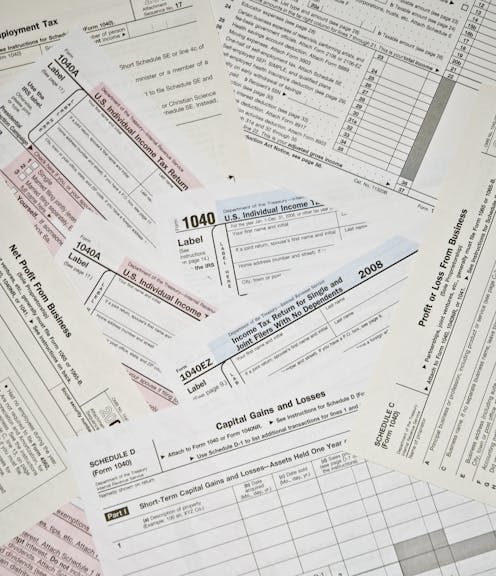Americans spend more time and money filing their taxes than residents of other countries — but there
The co-hosts of the ‘Taxes for the Masses’ podcast explain the upside and downside of all those credits and deductions.

Tax Day falls on April 18 in 2023. But if you’re one of the 20%-25% of Americans who wait until the last minute to file, don’t panic – you still have time.
The IRS estimates that the average taxpayer spends 13 hours to complete their return. If you own a business, the estimate increases to 25 hours. That said, filing can be tricky.
As accounting professors and hosts of the podcast “Taxes for the Masses,” we know the U.S. tax system is more complex than many other countries. That complexity, however, has benefits as well as drawbacks.
Simpler tax systems abroad
Although the U.S. income tax system asks individuals to devote their time to complete a tax return each year – or pay someone to do it for you – dozens of countries have found another way.
Some nations, such as the U.K., offer return-free systems where taxpayers have the exact correct amount of income tax withheld from their earnings during the year.
Other countries, such as Denmark and Spain, offer tax reconciliation systems whereby the tax authority fills out the return for the taxpayer using information from third parties, such as employers and banks, with knowledge of your financial goings-on. All the taxpayer must do is review the form and submit any corrections. These systems shift the costs of determining one’s tax bill – currently estimated to be over US$11 billion a year in the U.S. – from taxpayers to the government.
The goal of return-free and tax reconciliation systems is to withhold the exact right amount of tax during the year so there’s no need to true up these amounts to the actual tax liability. So why can’t the U.S. do something similar? Well, exact withholding is easiest to do when the tax code is simple. And the U.S. tax code is not simple.
In fact, when the Treasury Department reported to Congress in 2003 on the feasibility of a return-free system in the U.S., the report was titled Tax Simplification is a Prerequisite.
What makes the US system so complex?
A simpler system taxes each individual separately. The U.S., however, taxes single individuals and married couples differently. This approach makes it difficult to withhold the right amount of tax because the applicable tax rate depends on more than just your income. It includes, for example, that of your spouse, which your bank or employer may not know.
A simpler system would also have flat or fewer tax rates. Instead, the U.S. has numerous tax brackets, with the goal of ensuring that higher earners pay higher rates of income tax. Although progressive rate structures like this are aimed at fairness, in that those who can afford to pay more do pay more, this type of tax system adds complexity.
Other countries retain progressive systems with fewer tax brackets. For example, the U.K. currently has four tax brackets, compared with seven in the U.S.
The U.S. also has different rates for ordinary income such as wages versus income such as dividends and capital gains, which are typically taxed at lower rates – in part to spur investment and also because investment income has arguably already been taxed. But the U.S. system adds complexity because capital gains on investments held for less than a year and some dividends are not taxed at preferential rates. These different rates – from different levels and types of income – reduce the chances of getting withholding right.
The U.S. system also adds complexity with the sheer number of deductions and credits available to taxpayers. Deductions reduce the amount of taxable income you have, thereby reducing your tax liability. Say a single individual has $80,000 of wage income and $15,000 of deductions. Their taxable income is $65,000. At 2022 rates, their tax liability is $9,617. Those $15,000 of deductions saved them $3,300 in taxes.
Fortunately, there are a lot deductions. Unfortunately, taxpayers often have to jump through hoops to qualify. You can deduct gambling losses but only if you have gambling winnings, state income taxes but only up to $10,000 each year, and student loan interest but only if you make less than $85,000 or $175,000, depending on your marital status.
Further, these deductions come in different flavors: “above-the-line” deductions and “below-the-line” deductions, which themselves come in two flavors – itemized and standard. Taxpayers itemize deductions only if those amounts exceed the standard deduction. That means you might spend several hours tallying receipts for itemized charitable donations only to find you can’t deduct any of them because the total is less than your standard deduction.
Credits are another valuable element of the tax system because they reduce your tax liability dollar for dollar. Let’s go back to our single taxpayer with $65,000 in taxable income and a $9,617 tax liability before credits. A $1,000 credit – say for higher education or renewable energy – reduces their tax liability to $8,617. But credits also add complexity because they can be reduced as your income increases, and they can have extensive eligibility requirements.
Benefits of a complex system
One benefit of all this complexity is that it gives the tax system flexibility to provide economic stimulus and other responses to current events, like a global pandemic. For example, Congress allowed taxpayers to receive guaranteed tax benefits for some charitable contributions made during the pandemic as above-the-line deductions, instead of the usual requirement that taxpayers first determine whether they could itemize the charitable contribution as a below-the-line deduction.
Even if the U.S. could drastically simplify its tax system, a return-free or tax reconciliation system comes with its own problems. Transitioning would require a significant investment in IRS resources, and although in 2022 Congress passed an $80 billion boost to IRS funding over the next 10 years, much of this amount is needed to shore up the current system.
And estimates suggest that, at best, a return-free or tax reconciliation system in the U.S. would work for only 62 million taxpayers, meaning the majority of U.S. taxpayers would still have to complete a tax return because the withholding or pre-populated return wouldn’t be right.
Meanwhile, a simpler tax system potentially makes it more difficult for Congress to use tax policy to stimulate the economy or encourage certain desirable behaviors, such as investing in renewable energy.
Finally, exact withholding, when it works correctly, takes away the sizable refunds some Americans enjoy.
In the end, no tax system is perfect. The U.S. must decide whether the complexity of its tax system is worth the time and the average $250 cost taxpayers spend on filing their own returns instead of spending that on more pleasant activities.
The authors do not work for, consult, own shares in or receive funding from any company or organisation that would benefit from this article, and have disclosed no relevant affiliations beyond their academic appointment.
Read These Next
From truce in the trenches to cocktails at the consulate: How Christmas diplomacy seeks to exploit s
World leaders like to talk up peace at Christmastime. But alongside the tales of seasonal breaks in…
The world risks forgetting one of humanity’s greatest triumphs as polio nears global eradication − 7
Polio may finally be defeated in the next 5 years. Will the world recognize what an extraordinary achievement…
Medieval peasants probably enjoyed their holiday festivities more than you do
The Middle Ages weren’t as dreary and desperate as you’d think, and peasants often had weeks of…





